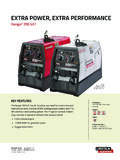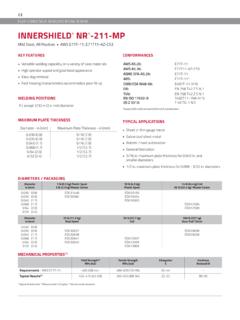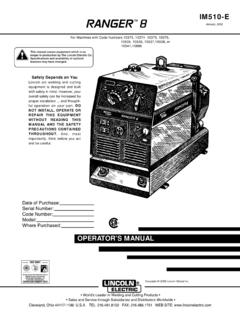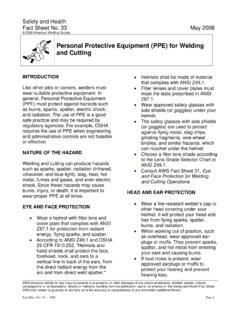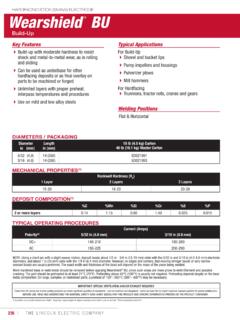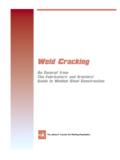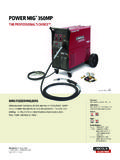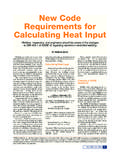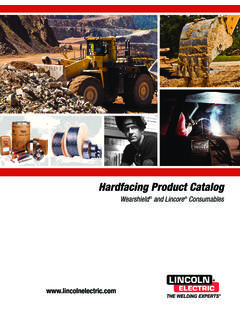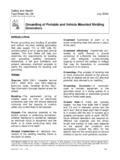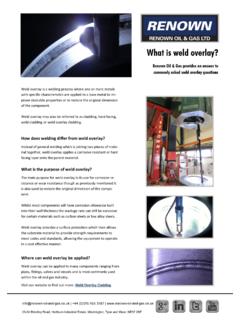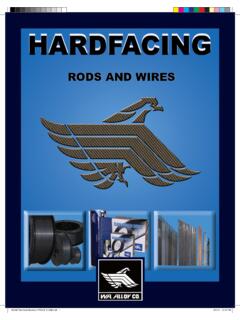Transcription of Hardfacing Product and Procedures Selection
1 Hardfacing Product and Procedure Selection 1 6/18/14 11:19 AM. Selection Guide to Lincoln Hardfacing Materials and Procedures Lists Recommended Materials and Methods for Hardfacing Over 200 Common Components Table of Contents Section 1: Introduction Section 6: Cement, Brick and Clay Benefits of Hardfacing ..3 Cement Mill Components ..27. Build-Up and Hardfacing ..3 Pulverizer Mill Components ..28. Consumable Selection ..3 Brick and Clay Manufacturing Components ..29. Applying The weld Deposits ..4 Other Industry Components ..30. Dependable Supply, Dependable Products ..4. Section 7: Dredging Section 2: Lincoln Product Data Dredge Pump Parts ..31-32. Lincoln Hardfacing Products ..5 Other Dredging Parts ..33. Hardfacing Applications & Selection of Products ..6. Competitive Product Comparison Charts ..7-9 Section 8: Iron and Steel Industry Components.
2 34-35. Section 3: Heavy Construction Steel Mill Roll Rebuilding ..36. Tractor Parts ..10 Foundry Parts ..37. Tractor and Shovel Parts ..11 Other Iron and Steel Applications ..37. Power Shovel, Dragline Buckets and Bucket Teeth Rebuilding ..12-13 Section 9: Other Industries Power Shovel Transmission Parts ..14-15 Rubber Industry Mixing Machines ..38. and Ditcher Parts Railroads ..39. Miscellaneous Logging ..39. Paper Pulp Digester Cladding ..40. Section 4: Mining Rebuilding Tool Joints ..41. Industry Components ..17-18 Rebuilding Other Drilling Equipment ..42. Mine Car Wheels ..19-20 Other Miscellaneous Applications ..42. Other Mining Industry Components ..21. Section 10: Procedures and Welding Techniques Section 5: Crushing and Grinding Process Selection ..43. Impact Crushers Components ..22-23 General Guidelines ..43-47. Other Crushing, Grinding & Screening General Welding Procedures .
3 47-49. Neutral Hardfacing Fluxes ..49. Special Feature: Hardfacing Tear-Out Chart ..25-26. Preheat Recommendation Chart ..50. 2. Introduction SECTION 1. Benefits of Hardfacing b. Severe Impact Wear from severe pounding which tends to squash, gouge and crack the Hardfacing is a low cost method of depositing wear surface. Manganese steel deposits, which work resistant surfaces on metal components to extend service harden in service, provide the greatest impact life. Although used primarily to restore worn parts to wear resistance. usable condition, Hardfacing is also applied to new components before being placed into service. c. Abrasion Plus Impact Wear from gritty material accompanied by heavy pounding which tends to In addition to extending the life of new and worn compon- chip or crack, as well as grind, away the surface. ents, Hardfacing provides the following benefits: d.
4 Severe Abrasion Wear from gritty materials Fewer replacement parts needed. which grind or erode the surface. Severe abrasion is often accompanied by heavy compression or Operating efficiency is increased by reducing moderate impact. Hard deposits are required to downtime. resist abrasion but they may also need substantial Less expensive base metal can be used. impact resistance. Overall costs are reduced. e. Metal-to-Earth Abrasion Wear from earth-like materials accompanied by moderate impact Build-up and Hardfacing (pounding.). Restoring worn parts frequently involves the following f. Corrosion Chemical attack. three steps: 1. Buttering For a deposit that will dilute the carbon In many, if not most cases, the effective wear is a and alloy content of base metal. result of a combination of two or more of the phenomena described in this section.
5 2. Build-up Seriously worn areas should be rebuilt close to working size using tough, crack-resistant 3. Arc Welding Method The choice of arc welding welding materials which can be deposited in an method depends primarily upon the size and number unlimited number of layers. of components, available positioning equipment and 3. Hardfacing Wear resistant surfaces deposited on frequency of Hardfacing . Available methods are as the base metal or on build-up deposits extend service follows: life. Hardfacing is usually limited to one, two, or three a. Manual Welding using stick electrodes requires the layers. least amount of equipment and provides maximum flexibility for welding in remote locations and all Consumable Selection positions. Welding material Selection depends upon three major b. Semiautomatic Welding uses wire feeders and factors: self-shielded, flux-cored Lincore electrodes increas- 1.
6 Base Metal Primarily affects the choice of ing deposition rates over manual welding. build-up materials. c. Automatic Welding requires the greatest amount of a. Manganese steel is used for components subject initial setup, but provides the highest deposition to high impact loading. Rebuild to size using rates for maximum productivity. It can be done with manganese steel weld deposits. combinations of: b. Carbon and alloy steel components are rebuilt to (1) Neutral flux and alloy wire. size using low alloy steel weld deposits. (2) Alloy flux and mild steel wire. (3) Self-shielded flux-cored wire with or without flux. 2. Type of Wear The primary consideration in select- ing the final Hardfacing layers is the type of wear to be encountered in service. These include: a. Metal-to-Metal Friction Wear from steel parts rolling or sliding against each other with little or no lubrication.
7 3. Applying the weld Deposits Distortion A small amount of distortion can destroy the usability of some parts. Rigid bracing, pre-bending, Cleanliness Remove rust, dirt, grease, oil and other skip welding and other distortion control techniques contaminants from the surfaces to be welded. may be required. Surface Preparation Badly cracked, deformed or Welding Procedures Obtain the recommended work hardened surfaces should be removed by starting Procedures from the appropriate Lincoln grinding, machining or carbon-arc gouging. Product literature or from Procedures and techniques, etc., in this manual. The Procedures and techniques Deposit Thickness Avoid excessive build-up of listed are general guidelines for specific applications. Hardfacing deposits or they may crack and break off Final responsibility must be that of the builder/user. rapidly in service.
8 If thick deposits are needed, use the appropriate build-up materials before Hardfacing . IMPORTANT: SPECIAL VENTILATION. Preheat and Interpass Temperature The combi- AND/OR EXHAUST REQUIRED. Fumes from the normal use of certain Hardfacing welding products contain nation of alloy content, carbon content, massive size significant quantities of components such as chromium and manganese and part rigidity creates a necessity to preheat in many which can lower the mg/m3 maximum exposure guideline for general welding fume. build-up and Hardfacing operations. (See the chart of recommended preheats at the end of this publication.) BEFORE USE, READ AND UNDERSTAND THE MATERIAL SAFETY. DATA SHEET (MSDS) FOR THIS Product AND SPECIFIC. Slow cooling may also be needed. Low or minimum INFORMATION PRINTED ON THE Product CONTAINER. preheat, low heat input, and low interpass temperature are used on Manganese steels.
9 Customer Assistance Policy The business of The Lincoln Electric Company is manufacturing and selling high quality Caution Manganese steel becomes brittle if welding equipment, consumables, and cutting equipment. Our challenge is to meet the overheated. While a 100 F to 200 F preheat may be needs of our customers and to exceed their expectations. On occasion, purchasers may ask Lincoln Electric for advice or information about their use of our products. We respond to our required, do not allow interpass temperatures to customers based on the best information in our possession at that time. Lincoln Electric is not in a position to warrant or guarantee such advice, and assumes no liability, with respect exceed 500 F. to such information or advice. We expressly disclaim any warranty of any kind, including any warranty of fitness for any customer's particular purpose, with respect to such information or Caution Some alloy steel components require a advice.
10 As a matter of practical consideration, we also cannot assume any responsibility for updating or correcting any such information or advice once it has been given, nor does the specific heat treatment to perform properly in service. provision of information or advice create, expand or alter any warranty with respect to the sale of our products. This must be considered when preheating and welding. Contact the part maker for information. Lincoln Electric is a responsive manufacturer, but the Selection and use of specific products sold by Lincoln Electric is solely within the control of, and remains the sole responsibility of the customer. Many variables beyond the control of Lincoln Electric affect the results obtained in applying these type of fabrication methods and service requirements. Dependable Supply, Dependable Products Lincoln Electric is the world's leading manufacturer of Quality and reliability also depend on careful Selection arc welding products.
